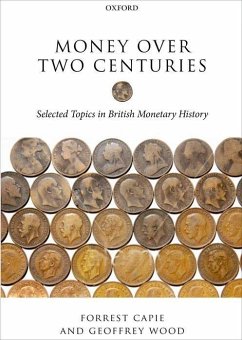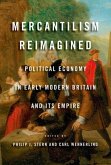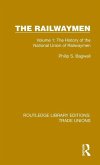- Gebundenes Buch
- Merkliste
- Auf die Merkliste
- Bewerten Bewerten
- Teilen
- Produkt teilen
- Produkterinnerung
- Produkterinnerung
This collection of essays by the eminent financial and monetary historians Capie and Wood examines and offers explanations of the parts played by money and the banking system in the British economy over the last two centuries. It deals with financial crises, periods of stability, and Britain in the international system.
Andere Kunden interessierten sich auch für
![Victorian Material Culture Victorian Material Culture]() Victorian Material Culture176,99 €
Victorian Material Culture176,99 €![Prometheus Shackled Prometheus Shackled]() Peter TeminPrometheus Shackled97,99 €
Peter TeminPrometheus Shackled97,99 €![Mercantilism Reimagined Mercantilism Reimagined]() Mercantilism Reimagined146,99 €
Mercantilism Reimagined146,99 €![The Railwaymen The Railwaymen]() Philip S BagwellThe Railwaymen104,99 €
Philip S BagwellThe Railwaymen104,99 €![Remaking English Society Remaking English Society]() Remaking English Society167,99 €
Remaking English Society167,99 €![Victorian Material Culture Victorian Material Culture]() Victorian Material Culture179,99 €
Victorian Material Culture179,99 €![Victorian Material Culture Victorian Material Culture]() Victorian Material Culture176,99 €
Victorian Material Culture176,99 €-
-
-
This collection of essays by the eminent financial and monetary historians Capie and Wood examines and offers explanations of the parts played by money and the banking system in the British economy over the last two centuries. It deals with financial crises, periods of stability, and Britain in the international system.
Hinweis: Dieser Artikel kann nur an eine deutsche Lieferadresse ausgeliefert werden.
Hinweis: Dieser Artikel kann nur an eine deutsche Lieferadresse ausgeliefert werden.
Produktdetails
- Produktdetails
- Verlag: Oxford University Press (UK)
- Seitenzahl: 378
- Erscheinungstermin: 25. Oktober 2012
- Englisch
- Abmessung: 234mm x 156mm x 22mm
- Gewicht: 703g
- ISBN-13: 9780199655120
- ISBN-10: 019965512X
- Artikelnr.: 35522284
- Herstellerkennzeichnung
- Libri GmbH
- Europaallee 1
- 36244 Bad Hersfeld
- gpsr@libri.de
- Verlag: Oxford University Press (UK)
- Seitenzahl: 378
- Erscheinungstermin: 25. Oktober 2012
- Englisch
- Abmessung: 234mm x 156mm x 22mm
- Gewicht: 703g
- ISBN-13: 9780199655120
- ISBN-10: 019965512X
- Artikelnr.: 35522284
- Herstellerkennzeichnung
- Libri GmbH
- Europaallee 1
- 36244 Bad Hersfeld
- gpsr@libri.de
Forrest Capie worked as an accountant for Ford Motor Company and as a civil servant in the Department of Trade and Industry in New Zealand, before reading economics and economic history at the University of Auckland and the London School of Economics. Amongst many books, he has written The History of the Bank of England, Depression and Protectionism, and was co-author of The Inter-War British Economy. He has also written papers on monetary and trade history and was editor of The Economic History Review from 1992-1999. He served on the Shadow Chancellor's advisory council from 1999 to 2004, and on the Shadow Monetary Policy Committee from 2002 to 2004. Geoffrey Wood has been Visiting Economist with the Bank of England, where from 1994 to 2004 he was a Special Advisor on Financial Stability. He has also been a Visiting Scholar at the Federal Reserve Bank of St Louis and the Federal Reserve Bank of New York, Visiting Professorial Fellow in the Centre for Commercial Law Studies at Queen Mary and Westfield College, University of London, and Visiting Professor at the University of Athens and the University of Oxford. He has served as a research adviser at the Bank of Finland and also advised the New Zealand Treasury. He has served for some time as Special Adviser to the Treasury Select Committee of the House of Commons. He is on the Editorial Boards of the Greek Economic Review, The Journal of Financial Education, and the European Journal of Political Economy, and is a General Editor of the Journal of Financial Regulation.
* 1: Introduction
* Part One
* 2: (with Professor Terence C. Mills): Money, Interest Rates, and the
Great Depression: Britain from 1870 to 1913
* 3: Money Demand and Supply under the Gold Standard: the United
Kingdom 1870 1914
* 4: Money in the Economy, 1870 1939
* 5: Deflation in the British Economy, 1870 1939
* 6: The Long Run Behaviour of Velocity in the UK
* Part Two
* 7: (with Professor Terence C. Mills): What Happened in 1931?
* 8: Debt Management and Interest Rates: the British stock conversion
of 1932 *
* 9: Policy Makers in Crisis: A Study of Two Devaluations
* 10: Price Controls in War and Peace: A Marshallian Conclusion
* Part Three
* 11: (with Dr Dimitrios Tsomocos): Modelling Institutional Change in
the Payments System and its Implications for Monetary Policy
* 12: Can EMU Survive Unchanged?
* 13: Central Banks and Inflation: An Historical Perspective
* 14: The IMF as an International Lender of Last Resort
* 15: Financial Crises from 1803 to 2009: the Crescendo of Moral Hazard
* 16: Central Banking in an Age of Uncertainty
* Part One
* 2: (with Professor Terence C. Mills): Money, Interest Rates, and the
Great Depression: Britain from 1870 to 1913
* 3: Money Demand and Supply under the Gold Standard: the United
Kingdom 1870 1914
* 4: Money in the Economy, 1870 1939
* 5: Deflation in the British Economy, 1870 1939
* 6: The Long Run Behaviour of Velocity in the UK
* Part Two
* 7: (with Professor Terence C. Mills): What Happened in 1931?
* 8: Debt Management and Interest Rates: the British stock conversion
of 1932 *
* 9: Policy Makers in Crisis: A Study of Two Devaluations
* 10: Price Controls in War and Peace: A Marshallian Conclusion
* Part Three
* 11: (with Dr Dimitrios Tsomocos): Modelling Institutional Change in
the Payments System and its Implications for Monetary Policy
* 12: Can EMU Survive Unchanged?
* 13: Central Banks and Inflation: An Historical Perspective
* 14: The IMF as an International Lender of Last Resort
* 15: Financial Crises from 1803 to 2009: the Crescendo of Moral Hazard
* 16: Central Banking in an Age of Uncertainty
* 1: Introduction
* Part One
* 2: (with Professor Terence C. Mills): Money, Interest Rates, and the
Great Depression: Britain from 1870 to 1913
* 3: Money Demand and Supply under the Gold Standard: the United
Kingdom 1870 1914
* 4: Money in the Economy, 1870 1939
* 5: Deflation in the British Economy, 1870 1939
* 6: The Long Run Behaviour of Velocity in the UK
* Part Two
* 7: (with Professor Terence C. Mills): What Happened in 1931?
* 8: Debt Management and Interest Rates: the British stock conversion
of 1932 *
* 9: Policy Makers in Crisis: A Study of Two Devaluations
* 10: Price Controls in War and Peace: A Marshallian Conclusion
* Part Three
* 11: (with Dr Dimitrios Tsomocos): Modelling Institutional Change in
the Payments System and its Implications for Monetary Policy
* 12: Can EMU Survive Unchanged?
* 13: Central Banks and Inflation: An Historical Perspective
* 14: The IMF as an International Lender of Last Resort
* 15: Financial Crises from 1803 to 2009: the Crescendo of Moral Hazard
* 16: Central Banking in an Age of Uncertainty
* Part One
* 2: (with Professor Terence C. Mills): Money, Interest Rates, and the
Great Depression: Britain from 1870 to 1913
* 3: Money Demand and Supply under the Gold Standard: the United
Kingdom 1870 1914
* 4: Money in the Economy, 1870 1939
* 5: Deflation in the British Economy, 1870 1939
* 6: The Long Run Behaviour of Velocity in the UK
* Part Two
* 7: (with Professor Terence C. Mills): What Happened in 1931?
* 8: Debt Management and Interest Rates: the British stock conversion
of 1932 *
* 9: Policy Makers in Crisis: A Study of Two Devaluations
* 10: Price Controls in War and Peace: A Marshallian Conclusion
* Part Three
* 11: (with Dr Dimitrios Tsomocos): Modelling Institutional Change in
the Payments System and its Implications for Monetary Policy
* 12: Can EMU Survive Unchanged?
* 13: Central Banks and Inflation: An Historical Perspective
* 14: The IMF as an International Lender of Last Resort
* 15: Financial Crises from 1803 to 2009: the Crescendo of Moral Hazard
* 16: Central Banking in an Age of Uncertainty








